
Military 16H detail variations (iss. 120)
 |
Military 16H detail variations (iss. 120) |
Back to change notice |
This page intends
to categorize all variations found on military 16H's, divided for Army and RAF
M/C's. Its based on pictorial evidence and contemporary spare parts lists. It
has to be kept in mind however that the spare parts lists show replacements,
which do not necessarily mean that the M/C's were originally made with the same
parts. Another uncertainty is the fact that M/C's were modified during the
production run. One very obvious example being the pannier toolboxes. They were
apparently applied to C6653 and the early part of C7353 only. Late C7353 M/C's
did not have them! There are indications that the
information in the spare parts lists lagged in relation to the real
motorcycle production because the spare parts list of C6653 does not
mention the pannier toolboxes.
I do not pretend to have it complete, but it will cover most variations. If
anybody can add more ("proven" with preferably original photographs or other
original spares parts lists) I will be glad to hear.
Arbitrary subdivision of variations of military 16H Nortons for the British and
Canadian Army
For
ease of reference I have subdivided the (WD)16H's in a number of
variations in which the motorcycles were initially produced.
If there were others, or the differences
can be made more specific, I would be glad to hear the details! I do not
have all "Spare parts lists" for the different contracts.
Looking at what I do have, there seem to be inconsistencies in parts used
and the expected time of application. It is also clear that bikes were
not always delivered as shown in the spare parts lists.
Below list is not exact. And it is very likely that changes were made while
production for a certain contract was still running, for instance when
using up old stock. The differences can be seen in the WD16H detail
variations
page. Sequence of variations is from "early" to
"late", where early is 1936 to 1939 (variation one and two), 1940-41
(variation three) and
"late" 1942 upwards (variation 4) and "last" (variation 5). Again this is not exact, and will
be updated when information becomes available. Finally some remarks are
made on the rebuilding of motorcycles.
Variation one:
Basic civilian looking motorcycle with rubber handlebar grips and foot rests,
civilian type rear number plate with rear light mounted in the right hand
corner and front number plates, no pillion arrangements, initially a
standard narrow civilian toolbox with
school bag type lock, from around 38 onwards a wider, deepened box , oil tank with weldings at the rear, Speedometer
mounted in the middle of the fork, 1 inch handlebar, headlamp
7"aperture, painted black out/black Manilla paper black out
(blackouts introduced after September 1939), forward facing horn, round ribbed head
tappet cover screw. The prop stand was mounted onto the left pillion
footrest lug, on bikes which required pillion footrests, they were fixed
to a clamp fitted around the chainstay tube in front of the original lug.
A number of these were equipped with dust filters
mounted at right hand side near the rear axle (for use in Palestine).
Variation two:
Basically similar to variation one, built for use in the Middle East
(Palestine, Egypt). It
was provided with a special air filter, mounted at the right hand above
the rear axle. This variation sometimes were provided with a crankcase bash plate,
approximately 1,5 times wider than those later used. Pictures do not show Speedometers.
There are however also versions like this without speedometer and
crankcase shields.
A variation of this one is the use of the tank top mounted Vokes filter
around 1939. This version is rather peculiar as pictures show these bikes
to have the right hand rear corner of the petrol tank cut-off. This was
apparently only done on these early contracts. Later in the war, when the
tank top Vokes was "re-introduced" the "standard, non-cut-off tanks"
remained where other brands like BSA and Triumph did change to right hand
rear cut-off tanks. As far as found, Norton was the first to use the tank
top Vokes filters and the spare parts lists of even the BSA and the VAOS
lists all refer to Norton part numbers.
Variation
three:
As variation one, but with two "pannier" toolboxes mounted high up on the
rear mudguard stays. These boxes were mounted at least on Contracts C6653
and V7353. Spare parts list for Contract C9062 also notes these boxes but
it is unlikely that they were ever fitted. Pictorial evidence suggests that the boxes were only mounted on
an "early" part of contract V7353 (august 1940). The deletion of pannier tool boxes
under V7353 came between C4391955 (W31929) and C4392670 (W32644).
(C4388560 did not have them but picture date uncertain and as bike also
misses speedo the boxes may have been removed).
Speedometer mounted at left hand side of the
fork instead of the centre of the front fork.
Pillion footrest lug added to lower left chain stay.
Note: spare parts list for C9062 also refers to the petrol tank with the
right hand rear corner cut-off.
Photographic evidence suggests that later parts of the contract (late
1941), the bikes were delivered with pillion seat equipment and pannier
bags (ref C4402582).
Variation
four:
As three but with pannier carriers and bags, pillion seat and footrests,
canvas handlebar grips, round bar steel footrests, winged bolts on toolbox
and tappet cover, 6 inch aperture headlamp, headlamp blackout mask, horn mounted
facing left, no civilian type number plates, blackout type tail
light, oil tank welded at the side. Based on the spare parts lists, the panniers were added starting with contract
C10217. DME circular states a retrofit date for panniers as from
31-3-1942. This was also the last contract on which the front fork
rubber buffers were mounted.
Variation
five:
As four but on
contract S2602 with bikes delivered in 1944 appear the first to which the
steering damper was deleted and the hole in
the steering column cap was closed by means of a rivet. Further configuration
as given for variation four.
Final variation:
Contract S5161,
as five, but with the standardised 7/8 inch handlebars and using BSA part numbers for all
handlebar controls (air, ignition, clutch, front brake and exhaust valve lever).
Later parts of the contract were provided with the petrol tank mounted Vokes filters
and tropicalised, (there was no right hand rear cut-out on the petrol
tank contrary to petrol tanks made in 1939/1940!). Tank rubbers not applied.
The front mudguard to front fork attachment bracket was modified to allow the
front end of the mudguard to rise upwards, likely to reduce the collection of
mud under the front end of the mudguard blocking the front wheel.
There are also
indications these machines were delivered with the simplified electrical system
as described in the electrical system page. No contemporary picture of
this has however been found to date.
Rebuilds:
In case of severe wear or damage of a motorcycle, they were completely
stripped to the smallest parts.
Good parts were kept, damaged parts restored (if usefull), worn parts
scrapped. Out of the kept, restored and new parts, complete
"new" motorcycles
were built. These motorcycles were built to the latest standard as
valid during the reassembly. There were special workshops turning
out machines at a rate of one each hour!
The rebuilt practice also means that engine and frames were mixed without scrupules. The motorcycle was provided with a new Army census number, and off it went, to be worn out again, scrapped or to be sold to the civil market after the war. It also explains why there are few machines left with matching engine and frame numbers. (Of these, some are known to be "fabricated").
Common upgrades:
During the operation of motorcycles, modifications were introduced as cure
for common faults (fracturing of front petrol tank lugs) or improvements (adding
of panniers). For the Army, these modifications were documented in "circulars", prepared
by the Director of Mechanical Engineering (DME). From these lists, modifications
for the Nortons can be found. It is however quite certain from pictorial
evidence that these modifications were not by definition introduced on all
bikes.
Arbitrary subdivision of variations of military 16H Nortons for the RAF
The RAF purchased over 3500 Nortons, a large part of those provided with a
Norton Model G (Swallow body?) sidecar.
Two categories can be described:
Early solo and sidecar machines:
Basically, these machines were identical to the Army machines upto late 1944,
with the same frame and engine parts.
Late sidecar machines:
Machines specifically used for sidecar work changed after late 1944. 18" x
4.00" wheels became standard on these M/Cs, replacing the until then
normally used 19" x 3.25
" wheels.
These late machines did have the pannier carriers as also found on the Army
bikes after 1941. RAF machines retained the 1" handlebar where the Army changed to
7/8th "handlebars around 1944/45. Universal saddles did find their way to
these machines, but only on the very late ones. The normal saddles were phased
out during the manufacture and use of these bikes.
Common upgrades:
As for the Army, the RAF M/C's were also upgraded when necessary. The RAF used AP1726 coded documents to introduce
the modifications.
India Office (India Stores)
Variation one:
In Jan 1937 73 India Office MC's were produced which were basically similar to the ones as built for the British Army
apart from the addition of the pillion footrest lug on left lower chainstay,
pillion equipment, rearward extending rear carrier, silencer with raised outlet,
"modified" Vokes (pictorial evidence indicates to the tank top Vokes)
, lifting handle to front mudguard. The bikes were also provided with a non-trip
80 MPH speedo and a wide (8 1/16") crankcase shield.
Variation two:
Further
1937 models were manufactured in Feb 1938, 136 in March, 30 in April, but these
were delivered with 1938 style rear mudguards (Khaki coloured).
August 1938 saw the first of the 1938 model (enclosed valves, side mounted
saddle springs, 1938 civilian style oil tank but not the 1938 "cows udder"
silencer) with 130 produced. Further production was 250 in September, 140
in October, 104 in November and 28 in December.
In July 1939 another 9 1938 models were produced (Matt brown finish).
These machines were also supplied with the raised silencer, pillion equipment
and rearward extending rear carrier, wide crankcase shield and 80 MPH non-trip
speedo.
In 1946 another 80 MC's of 1938 model, fitted with the Talflow air cleaner were made for India Office.
Australia
Australia purchased a small number of MC's independently prior to WW2. The MC's were basically the standard British military but with the Vokes tank top filter and cut-out at right hand rear of the petrol tank. Around 1940 a fair number of machines were purchased with numbers in the W12xxx range.
New Zealand
Purchased 6 standard British Army MC's but with the smaller crankcase
shield. They were built late december 1937 but delivered March 1938.
Based on numbers found, there appears to have been a number of additional 1940
machines built inbetween the Australian machines with frame numbers in the
W12xxx range.
Crown offices (Malaysia)
Pictorial views of the differences:
First variation mentioned in each row is the oldest, variations in one column
not necessarily same time frame between rows.
The contract numbers given in the list below are based on the spare parts
lists available.
Where an original picture was not at hand, a present time picture is used. If
somebody wants a bigger picture of some part, please drop me a line through the
E-mail.
Parts which to my knowledge have not changed are not
mentioned.
| Item
|
Variation one | Variation two | Variation three | Variation four | Variation five | Variation six |
| Front number plates | 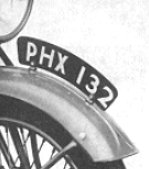 Civilian type given for bikes upto and including C9062 |
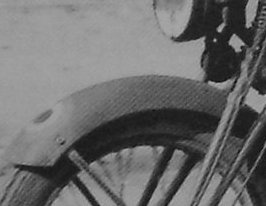 No numberplate from C10217 onwards |
||||
| Rear number plate |
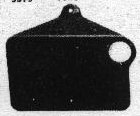 Civilian type single top bolt, actually used upto and including C9681. According to spare parts list it was still used upto and including C5109. |

Civilian type double top bolts from C1666 upto C9062 |
 None as from C10217 |
|||
| front mudguard handgrip |
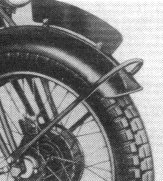 Part of front stay, India office contracts only? |
 None, standard on all others |
||||
| Rear mudguard | 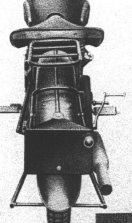 central rib |
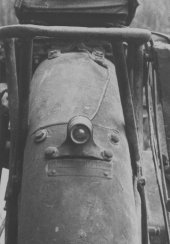 Plain, unribbed |
||||
| Rear mudguard flap |
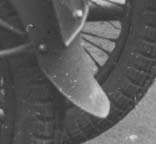 Long curvature |
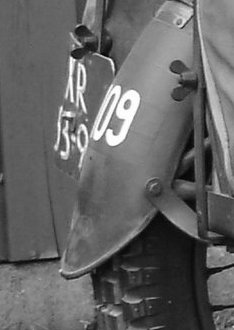 Short curve (C5612 and upwards) |
||||
| Leg shields |
 |
First 500 bikes from Contract C14498 only! | ||||
| footrests |  Rubber D shaped, all contracts upto and including C9062 |
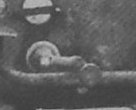 Round steel C10217 and upwards |
||||
| pillion footrests | None added, right hand lug present, left hand not | Rubber, covered |
 Steel, uncovered |
|||
| Pillion seats |  None |
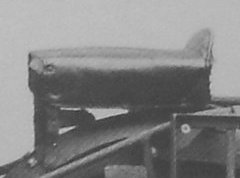 Spring frame |
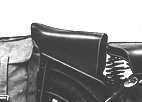 Loaf |
|||
| Speedometers | 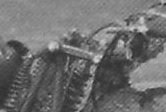 None |
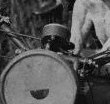 Centrally mounted |
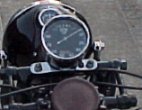 Centrally mounted top view |
 Left hand mounted (C5612 and upwards) |
 Left hand mounted top view |
|
| Speedometer Fork Attachment brackets | upto and including first part of contract C5612 (changed inbetween C4153287 and C4154277), part no 3884 , central mounting | Later part of C5612 and higher, part no 4114, left hand mounting | from contract C14498 to end, part no 4114a | |||
| Toolbox(es) |
 Single box, 3 inch deep |
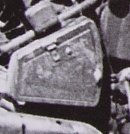 single box, 4 1/2 inch deep, early box widend with 1 inch strip between front and back pressing |
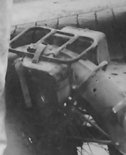 Double "pannier" boxes |
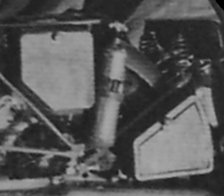 Both, believed to be a personal "modification" as is the addition of a fire extinguisher. |
Later versions of the wide box with gravity wing toolboxes had a chain
and paper clip on the inside of the lid. 5 inch deep. |
|
| Tool box locks |
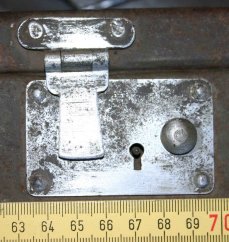 schoolbag type |
 Round knob also used on "pannier" toolboxes |
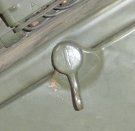 Winged "gravity" knob, |
|
||
| Rear carriers |
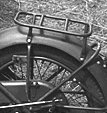 Rear carrier without pillion, basic as from 1936 |
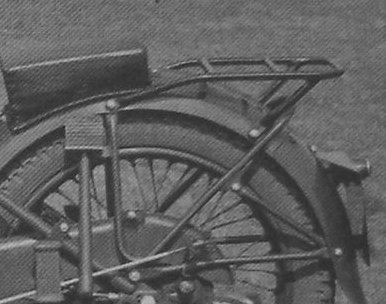 Pre war rear carrier with pillion option seen in 1937/38 on India Office MC's |
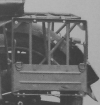 Panniers std as from 1942 |
 Rear carrier without pannier frames |
||
| Air cleaners |
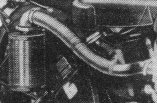 Rear mouted (1936 and later) |
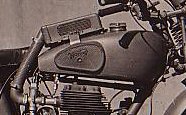 Norton Air cleaner with non adjustable straps to knee grip bolts and non adjustable elbow fitted to carburetter 1938/39 |
 Vokes model D.7226 with adjustable fixing on knee grip bolts and adjustable aluminium elbow to fit to carburetter 1943 upwards if fitted. |
|||
| Handle bar clips | Aluminium 1" only | Cast/Forged steel both 1" and 7/8th " | ||||
| Handle bars | 1 inch all contracts except S5161 | 7/8th inch, S5161 only | ||||
| Handlebar levers |
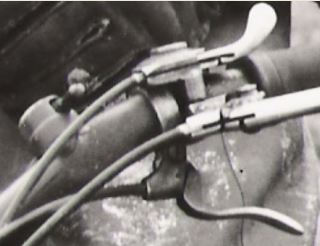 prewar combination levers upto 1939? |
prewar combination levers upto 1939? |
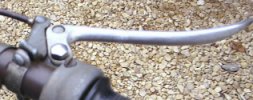 1939 upto 1942? |
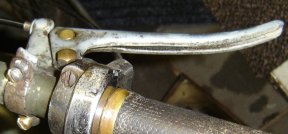 1942 upwards? |
||
| Steering damper | present on all contracts except S5161 | no steering damper on S5161 | ||||
| Fork buffer |
 All bikes upto and including contract C10217 have buffers |
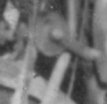 All bikes from C11082 (W60001) no buffers |
||||
| Head lamp |
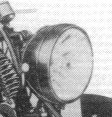 8" outer diameter, 7 1/2" aperture |
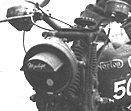 7" outer diameter, 6 1/2" aperture |
||||
| Head lamp switch | OLH (Off, Low, High) |
 OTLH (Off, Tail, Low, High introduced late 1939 |
||||
| Dimmer switch | Civilian dip switch on left hand side of handlebar | Dipper switches removed as from end of 1940 | ||||
| Black-out mask |  None |
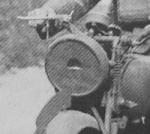 Black Manilla paper circular mask with half circular cut out. Bottom portion of reflector painted black |
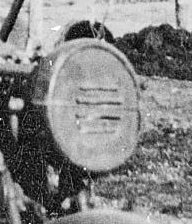 Quadruple slotted without overhead cover, probably locally made |
 Tubular, interim version mostly used on UK home defense bikes and civilian bikes. |
 Single slot overhead covered |
 With parking light |
| Rear light |

Civilian type MT110 with blackout Manilla paper tube blocking most of numberplate lighting. |
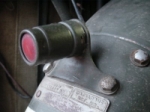 Military type |
||||
| Horn |
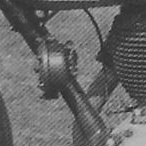 Mounted forward facing on clamp around front down tube |
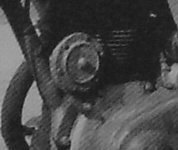 Mounted sideways facing on extending stud on engine bolt |
||||
| Magdyno platform | Aluminium casting | Cast iron | ||||
| Tappet cover | 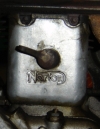 Cast aluminium upto and including C12426 |
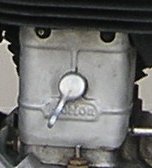 Pressed steel as from C14498 |
||||
| Engine tappet cover screw |  Round knob |
 Winged "gravity" knob |
||||
| Crankcase shield |  None |
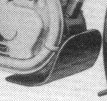 Wide version India office and Spanish M18's |
 Narrow version, first used on New Zealand machines 1937, re-introduced for all machines from C14498 |
|||
| Oil tank |
Rear welded |
 Side welded |
|
|||
| Petrol tank | 
With knee rubbers |
 With righ hand rear cut off to cater for Aircleaner hose. Specified for 1939 India contract and contract C9062 |

Without knee rubber bolt fixing holes, only on very late production machines of S5161 |
|||
| Petrol lead(s) to carburetter | Copper (upto W18000) | Rubber hose from each petrol tap onto two sided banjo on float chamber (after W18001) | After 1942 rubber hose from left tap and copper crossfeed line between petrol taps | |||
| Rear brake rod |
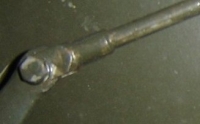 Rear end adjustable, all bikes pre 1942/panniers |
|
||||
| Wheel bolts |
|
|
||||
| Front brake cam lubrication | through centre of cam | by additional lubricator on side of bush (C10217 and upwards) | ||||
| Gear position indicator | moulded/cast part and indication of neutral by I on gearchange mechanism cover | At least from C6127 sheet metal pointer and gear positions on brass strip on top of gear change mechanism cover | ||||
| Gearbox drain plug |
|
|